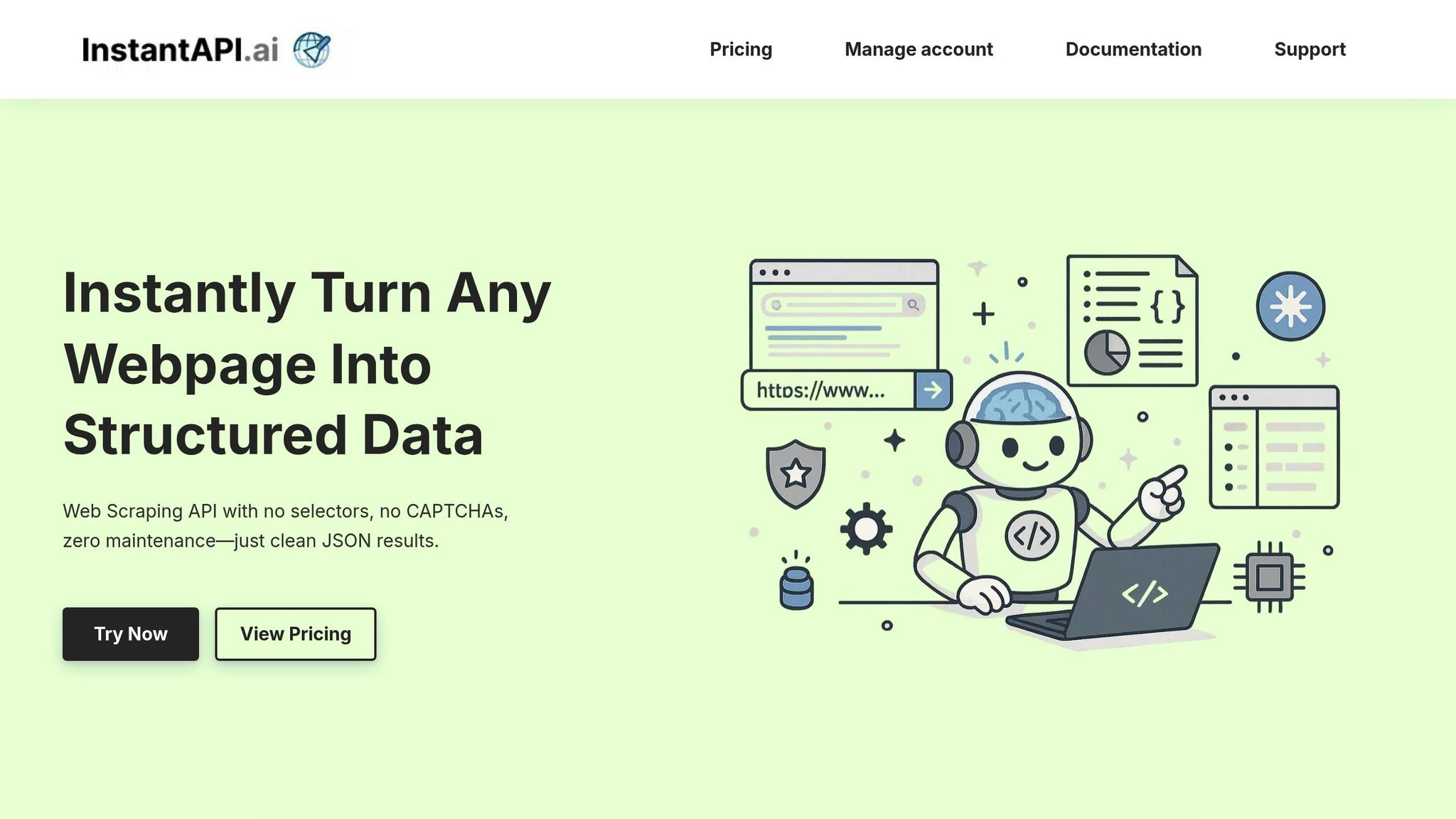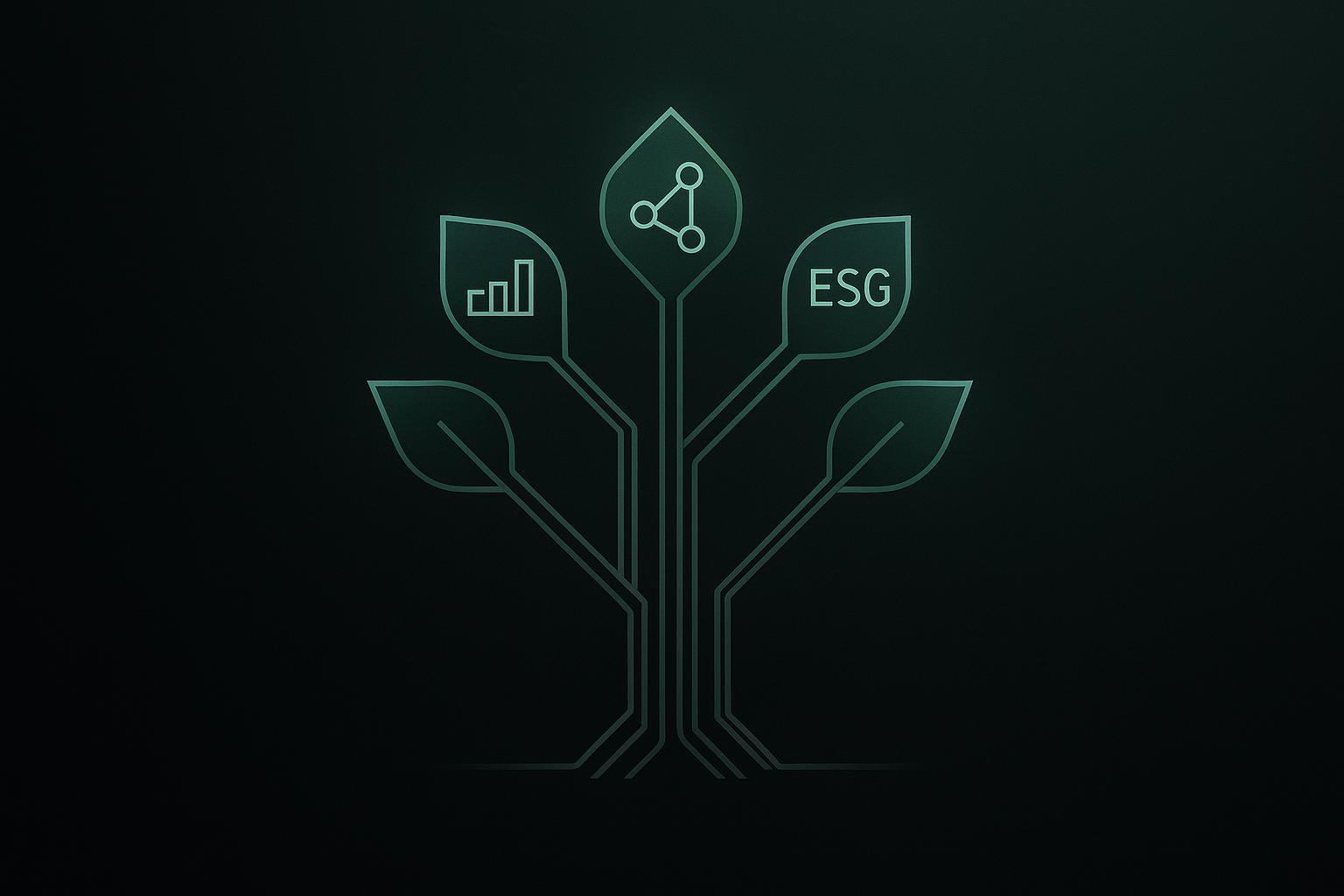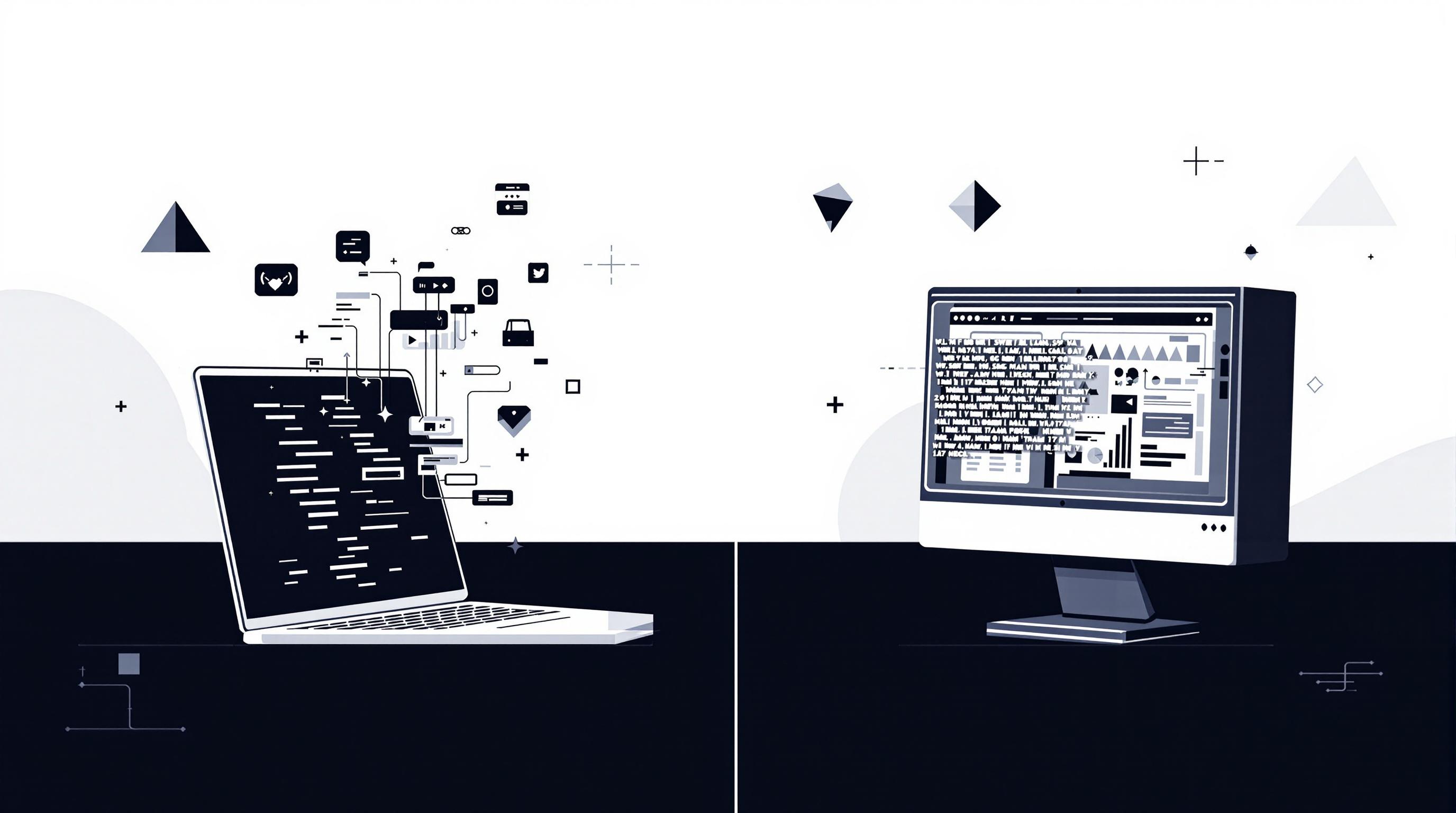Web scraping is transforming retail banking by helping banks collect and analyze data to improve services, manage risks, and stay competitive. Here's how it’s making an impact:
- Competitive Intelligence: Banks can monitor competitors' interest rates, fees, and loan terms to adjust their own offerings and maintain market share.
- Market Analysis: Real-time data on economic trends, stock prices, and customer sentiment helps banks stay ahead of market changes.
- Customer Experience: By analyzing customer behavior, banks can offer personalized services, increasing retention by 20–30% and reducing acquisition costs by 30–50%.
- Risk Management: Advanced tools detect fraud and monitor security risks, reducing loan losses by 40%.
Key Tool: AI-powered solutions like InstantAPI.ai enable efficient, compliant data collection at $2 per 1,000 pages scraped, offering banks speed, accuracy, and cost savings.
Quick Benefits:
- Revenue growth: 42% higher returns
- Better risk management: 40% reduction in loan losses
- Enhanced customer retention: 30% better market adaptation
Web scraping is reshaping how banks operate, combining real-time insights with compliance to create a data-driven future for banking.
Screen scraping: a balancing act for banks
Web Scraping Uses in Retail Banking
Web scraping plays a crucial role in improving retail banking services and staying competitive. Let’s dive into some of the key ways this technology is reshaping banking through automated data collection.
Tracking Competitor Data
Web scraping allows banks to keep a close eye on market trends and competitor strategies. This is especially important since product price comparisons account for up to 61% of website visits. By analyzing competitor loan rates, fees, and terms, banks can fine-tune their own offerings to maintain market share and profitability.
| Monitoring Area | Data Points | Business Impact |
|---|---|---|
| Lending Products | Interest rates, fees, terms | Adjust loan offerings and refine pricing |
| Customer Sentiment | Reviews and feedback | Enhance services and product offerings |
These data-driven insights help banks respond to market shifts quickly and efficiently.
Market Analysis and Trends
Banks also rely on web scraping to gather intelligence on economic indicators, financial trends, and market sentiment. This allows them to stay ahead of the curve by:
- Tracking fluctuations in stock and commodity prices
- Monitoring changes in currency exchange rates
- Analyzing market news and sentiment
- Collecting economic data from government and private sources
For example, in 2015, a tweet from investor Steve Ballmer about Twitter's innovations caused a 5% spike in the company's stock price. This highlights how real-time sentiment can directly influence financial markets.
Customer Experience Improvement
Web scraping goes beyond competitive analysis and trend tracking - it also helps banks deliver a more personalized customer experience. By analyzing customer behavior and preferences, banks can create tailored services that significantly improve engagement.
Here’s how personalization impacts banking:
- Customer retention improves by 20–30%
- Customer acquisition costs drop by 30–50%
- Conversion rates for personalized offers rise by 25–40%
Take Capital One, for instance. By analyzing customer spending habits and interactions, the company increased engagement by 40% through personalized credit limits and product recommendations. Similarly, DBS Bank leveraged AI-driven analysis of scraped data to provide customized investment advice, boosting investment product sales by 33%.
These examples show how web scraping empowers banks to not only understand their customers better but also create meaningful, data-backed connections.
Web Scraping Tools for Banking
As the financial world increasingly relies on real-time data analysis, AI-powered web scraping tools have become a critical asset for modern banking. These tools not only streamline data collection but also ensure adherence to regulatory standards. Let’s explore how solutions like InstantAPI.ai are helping banks stay ahead in this data-driven landscape.
InstantAPI.ai Core Functions

InstantAPI.ai offers web scraping capabilities designed specifically for banking needs, with a simple and transparent pricing structure - $2 per 1,000 web pages scraped. This pay-as-you-go model lets banks scale their data collection without the burden of hefty upfront costs.
Here’s how its features align with banking applications:
| Feature | Banking Application | Business Impact |
|---|---|---|
| Dynamic Content Handling | Real-time rate monitoring | Faster market response |
| Automated Data Extraction | Competitor analysis | Smarter pricing strategies |
| Structured Data Output | Financial reporting | Easier compliance management |
| Scalable Solutions | Market surveillance | Lower operational costs |
Benefits of AI Scraping Tools
AI-powered scraping tools bring a range of advantages that make them indispensable for banks:
- Accuracy: Advanced filters ensure high-quality, noise-free data.
- Speed: Process thousands of data sources simultaneously.
- Compliance: Automatically adheres to data privacy regulations.
- Cost Efficiency: Reduces reliance on manual processes and minimizes errors.
"As we live in an era where everything is fast-moving, web scraping with the help of AI is critical for organizations, as it helps them save time with data gathering and collecting as well as gain some of the upper hand in the information economy." – Jyothish R, Forbes Councils Member
Growth and Legal Requirements
The web scraping market for AI applications is forecasted to grow at an impressive 17.8% CAGR from 2023 to 2033, reaching a market value of $3.3 billion. This rapid expansion makes legal compliance more crucial than ever. Recent legal cases, like the Meta vs. Bright Data decision in 2024, have clarified the rules for scraping public data, providing banks with much-needed operational clarity.
To ensure compliance, banks must prioritize:
- Data Access Verification: Scraping only publicly accessible data.
- Privacy Protection: Avoiding the collection of personal information.
- Terms of Service Compliance: Respecting the policies of websites being scraped.
For banks, the stakes are high. Data breaches cost financial institutions an average of $5.97 million, making it essential to choose tools that combine strong security features with compliance safeguards.
sbb-itb-f2fbbd7
Web Scraping Implementation Guide
Web scraping in retail banking requires careful attention to data quality, strict legal compliance, and efficient performance tuning.
Ensuring Data Accuracy
Data accuracy is non-negotiable in banking, where even small mistakes can lead to serious financial consequences. InstantAPI.ai’s validation system offers several layers of protection to keep your data reliable:
| Validation Layer | Purpose | Implementation Method |
|---|---|---|
| Field Validation | Ensure consistent data format | Automated type checking |
| Cross-Reference | Verify data accuracy | Compare data across multiple sources |
| Anomaly Detection | Spot unexpected errors | AI-driven pattern analysis |
| Change Tracking | Maintain version history | Automatically log changes |
To ensure your data stays accurate, follow these steps:
-
Initial Data Validation
Before data even enters your system, set up stringent validation rules. Automated checks should cover:- Format and value range consistency
- Detection of missing fields
- Elimination of duplicate entries
-
Continuous Monitoring
Use real-time monitoring tools to track data quality metrics and quickly address any anomalies.
While maintaining accuracy, it’s equally important to follow all legal and ethical standards.
Legal and Ethical Compliance
The banking industry operates under strict regulations when it comes to data collection. To stay compliant, make sure to:
- Review and adhere to website Terms of Service
- Respect the guidelines outlined in robots.txt files
- Keep detailed logs of scraping activities for audits
- Implement clear data retention policies
- Stay updated on regulatory changes that could impact scraping practices
Document your adherence to laws like the CFAA and GDPR, and regularly revise your protocols to reflect any updates.
Once your data is accurate and compliant, focus on optimizing your system’s performance.
Performance Optimization Tips
A well-optimized scraping setup can save time and resources. Here’s how you can make your system more efficient:
Request Management
- Limit the number of simultaneous requests to a few per domain
- Use an exponential backoff strategy for retries
- Schedule scraping during off-peak hours to reduce server load
Resource Optimization
Efficient resource management can drive down costs while maintaining performance. Consider these best practices:
| Optimization Area | Best Practice |
|---|---|
| Proxy Management | Rotate IP addresses every 100 requests |
| Cache Implementation | Cache unchanged data for 24 hours |
| Request Throttling | Add a delay between requests (e.g., 1 second) |
Additionally, configure your system to respect rate limits and crawl delays as specified by each website.
Results and Success Metrics
By applying the outlined implementation strategies, banks have been able to measure the tangible benefits of web scraping. Institutions leveraging extensive data collection are proving to be 2.3 times more adept at identifying new market opportunities, giving them a competitive edge.
Performance Numbers
The impact of web scraping on retail banking can be tracked through key financial and operational metrics:
| Metric Category | Key Indicator | Industry Benchmark |
|---|---|---|
| Revenue Growth | Market Analysis ROI | 42% higher returns |
| Risk Management | Loan Loss Prevention | 40% reduction |
| Market Intelligence | Opportunity Detection | 2.5x revenue growth |
Banks employing advanced data analysis techniques report 25% higher revenue growth and improved customer acquisition rates.
Service Quality Metrics
Customer satisfaction measurement has evolved significantly with the use of advanced data analysis tools:
-
Net Promoter Score (NPS)
Banks leveraging web scraping for customer insights have seen notable improvements in their NPS. Real-time feedback allows them to make swift adjustments to enhance service quality. -
Customer Satisfaction Score (CSAT)
Using sentiment analysis from scraped customer reviews, banks can quickly identify and resolve issues. Notably, 76% of banking executives prioritize improving market analysis capabilities, highlighting the strategic importance of these efforts. -
Customer Retention Metrics
By integrating market insights effectively, financial institutions adapt 30% better to market shifts, resulting in stronger customer retention rates.
These metrics highlight how data-driven approaches are reshaping banking operations and customer experiences.
Success Story: Data-Driven Banking
A compelling example of these advancements comes from Wells Fargo. In September 2020, the bank partnered with Envestnet | Yodlee to replace 99% of its third-party financial app screen scraping with secure API-based data exchanges.
"Banks exaggerate [the security risks] because they don't have control. They're becoming just dump repositories for money."
- David True, Partner at PayGility Advisors
This shift led to:
| Area | Impact |
|---|---|
| Data Security | 99% coverage through secure API connections |
| Service Integration | Simplified third-party app connectivity |
| Customer Trust | Enhanced transparency in data handling |
Another success story comes from Eagle Alpha’s prediction of GoPro’s sales performance in 2015. By analyzing real-time data from electronics retail websites, they accurately forecast lower-than-expected sales - a feat that underscores the value of web scraping for market intelligence and informed financial decisions.
With results like 42% higher returns, 2.5x revenue growth, and significant improvements in risk management, web scraping has proven to be a game-changer. It not only enhances operational performance but also raises the bar for customer service in retail banking.
Conclusion: Future of Banking with Web Scraping
Web scraping is transforming retail banking, reshaping how banks interact with customers and handle risk. This shift is paving the way for even more advanced technologies. The future of banking is set to revolve around AI-driven data extraction and secure API integrations, with nearly half (48%) of banks planning to invest in enhanced API connectivity to strengthen partnerships.
These advancements are unlocking new strategic possibilities. By combining web scraping with AI and predictive analytics, banks are pushing the boundaries of innovation. A recent survey highlights increasing customer interest in open banking services, signaling a growing acceptance of data-powered banking solutions.
"In an industry where information is power, the ability to collect and analyze real-time financial data will define the future of banking."
- Andrius Palionis, VP of Enterprise Sales at Oxylabs
The move toward transparency and consent-driven practices is another major trend. For instance, Wells Fargo's switch to API-based data exchange in September 2020 resulted in 99% coverage of third-party financial app connections. This transition marks a clear departure from traditional screen scraping, favoring more secure and regulated approaches.
Here are some key factors shaping the future of banking:
| Future Banking Pillar | Expected Impact |
|---|---|
| API Integration | 580 billion calls projected by 2027 |
| Customer Adoption | 45% of U.S. national bank customers interested in open banking |
| Collaborative Models | 74% of banks consider collaboration essential |
| Investment Focus | 48% prioritizing improved API connectivity |
As the banking industry evolves, the focus will increasingly shift toward ethical data practices and compliance with regulations, all while driving innovation. Striking the right balance between progress and responsibility will be essential as banks continue to use web scraping to enhance services and improve risk management. With technology and regulations advancing side by side, banks must remain agile to sustain this momentum and thrive in the data-driven future.
FAQs
How does web scraping improve customer experience in retail banking?
Web scraping plays a key role in helping retail banks enhance the customer experience by offering real-time insights into what customers want and how they behave. With this data in hand, banks can design personalized products and services, like tailored loan options or customized financial advice, that align with individual needs.
It also allows banks to keep a close eye on market trends and competitor activities, ensuring they remain relevant and competitive. By automating data collection, banks can streamline operations, respond to customer inquiries more quickly, and make better-informed decisions. The result? A smoother and more engaging experience for customers.
What legal and ethical issues should banks consider when using web scraping technologies?
When employing web scraping tools, banks must tread carefully to address legal and ethical concerns while safeguarding compliance and trust.
On the legal front, banks are required to follow data protection laws such as GDPR and CCPA, which set strict rules for collecting and processing personal information. Failing to comply with these regulations can result in steep fines and damage to their reputation. It's also critical to honor website terms of service - violating these terms through unauthorized scraping can lead to costly legal battles.
From an ethical standpoint, banks should focus on practices that respect privacy and maintain integrity. This includes obtaining consent when required, anonymizing data to shield individual identities, and steering clear of collecting sensitive or private information without proper authorization. Improper use of scraped data not only risks privacy violations but can also erode consumer trust. Keeping up with current legal rulings and industry standards is vital to ensure web scraping activities remain both responsible and lawful.
What are the main advantages of using AI-powered web scraping tools like InstantAPI.ai in retail banking?
AI-powered web scraping tools bring a lot to the table for retail banking. They give banks real-time insights into market trends and competitor strategies, helping them make smarter, data-backed decisions. By automating the process of data collection, these tools cut down on manual tasks and boost efficiency.
On top of that, they play a key role in improving customer experiences. By analyzing consumer behavior and preferences, banks can offer more tailored financial products and services. These tools also excel at handling dynamic content, ensuring accurate data, which is crucial for compliance and managing risks. In short, AI web scraping tools help banks stay ahead of the curve while improving the quality of service they provide.


